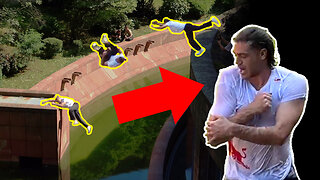Two Solar Cycles at Once & A Big Meteor Nearly Hits | Space Weather News 10.10.2019
This episode of Weather News is sponsored in part by 3ric Johanson: http://instagram.com/scubist
Our Sun keeps our attention focused even though space weather remains reasonably quiet this week. We have had several bright regions appear in Earth-view. The largest of these regions was strong enough to be officially designated as a sunspot (region 2749) from Solar Cycle 24. But then two high latitude bright regions emerged, one in the north and one in the south. These two regions both had Solar Cycle 25 polarity, which means this is one of the rare moments when we have active regions from two different solar cycles in both the northern and southern hemispheres in view at the same time! Unfortunately, if you blinked, you missed this rarity, as the new regions faded quite quickly. As a result, the solar flux has remained low and radio propagation continues to be poor on Earth's dayside. We do have a remnant coronal hole rotating through the Earth-strike zone now. Its been sending us some sporadic fast solar wind, which has bumped us up to active conditions sporadically. However, aurora views are expected to be sporadic and elusive, especially at mid-latitudes. Take a closer look at the ongoing solar activity, including the new active regions, see how the fast solar wind hitting now will affect you, and learn about the meteor that nearly hit the ground in Southern California this week!
Want early access to these forecasts and more? Join me at:
http://patreon.com/spaceweatherwoman
For daily and often hourly updates (during active times) visit me on Twitter:
https://twitter.com/TamithaSkov
For a more in-depth look at the data and images highlighted in this video see these links below.
Solar Imaging and Analysis:
SDO: http://sdo.gsfc.nasa.gov/data/
Helioviewer: http://www.helioviewer.org/
Flare Analysis: http://www.lmsal.com/solarsoft/latest_events/
Computer Aided CME Tracking CACTUS: http://www.sidc.oma.be/cactus/out/latestCMEs.html
GOES Xray: http://www.swpc.noaa.gov/rt_plots/xray_1m.html
SOHO: http://sohodata.nascom.nasa.gov/
Stereo: http://stereo.gsfc.nasa.gov/
GONG magnetic field synoptic movie: https://gong.nso.edu/data/magmap/standard_movie.html
GONG magnetic field synoptic charts: http://gong.nso.edu/data/magmap/
LMSAL Heliophysics Events HEK http://www.lmsal.com/isolsearch
Solar Wind:
DISCOVR solar wind: http://www.swpc.noaa.gov/products/real-time-solar-wind
ACE Solar Wind: http://www.swpc.noaa.gov/products/ace-real-time-solar-wind
NASA ENLIL SPIRAL: https://iswa.gsfc.nasa.gov/IswaSystemWebApp/iSWACygnetStreamer?timestamp=2038-01-23+00%3A44%3A00&window=-1&cygnetId=261
NOAA ENLIL SPIRAL: http://www.swpc.noaa.gov/products/wsa-enlil-solar-wind-prediction
Magnetosphere, Ionosphere, Atmosphere:
GOES Magnetometer: http://www.swpc.noaa.gov/products/goes-magnetometer
Ionosphere D-Region Absorption (DRAP) model: http://www.swpc.noaa.gov/products/d-region-absorption-predictions-d-rap/
Auroral Oval Ovation Products: http://www.swpc.noaa.gov/products/aurora-30-minute-forecast
Global 3-hr Kp index: http://www.swpc.noaa.gov/products/planetary-k-index
Wing Kp index prediction: http://www.swpc.noaa.gov/products/wing-kp
USGS Ground Magnetometers: http://geomag.usgs.gov/realtime/
USGS Disturbance Storm-Time (Dst): http://geomag.usgs.gov/realtime/dst/
NAIRAS Radiation Storm Model: http://sol.spacenvironment.net/raps_ops/current_files/globeView.html
Multi-Purpose Space Environment Sites:
NOAA/SWPC: http://www.swpc.noaa.gov
SOLARHAM: http://www.solarham.net/index.htm
Spaceweather: http://spaceweather.com
iSWA: http://iswa.gsfc.nasa.gov/iswa/iSWA.html
Definition of Geomagnetic Storm, Radiation Storm, and Radio Blackout Levels:
http://www.swpc.noaa.gov/NOAAscales/
None of this would be possible without the hard work and dedication of those who have provided all of this data for public use.
Images c/o NASA/ESA/CSA (most notably the superb SDO, SOHO, ACE, STEREO, CCMC, JPL & DSN teams, amazing professionals, hobbyists, institutions, organizations, agencies and amateurs such as those at the USAF/HAARP, NICT, NOAA, USGS, Environment Canada, Natural Resources Canada, Intellicast, Catatania, rice.edu, wisc.edu, sonoma.edu ucalgary.ca, rssi.ru, ohio-state.edu, solen.info, and more. Thanks for making Space Weather part of our every day dialogue.
-
 9:46
9:46
Dr. Tamitha Skov
8 months ago $0.02 earnedDark Farside Regions Come with Aurora & Meteors for New Years | Space Weather News 30 December 2023
1701 -
 LIVE
LIVE
Graham Allen
2 hours agoLEAKED $150,000 Bounty To K*LL Trump!! THIS IS THEIR PLAN!! + Biden Is Going On The View?!
8,341 watching -
 LIVE
LIVE
Matt Kohrs
8 hours agoChina's Emergency Bailout, Breaking Market News & Live Trading || The MK Show
2,434 watching -
 LIVE
LIVE
MTNTOUGH Fitness Lab
20 hours agoBuild a UNBREAKABLE MIND: The Most Ridiculous MINDSET You Need To Succeed In The Mountains | Ep #83
352 watching -
 LIVE
LIVE
2 MIKES LIVE
11 hours agoThe Mike Schwartz Show 09-24-2024
275 watching -
 35:47
35:47
BonginoReport
3 hours agoNo One Is Safe: Cartels with Explosive Artillery at Open Border (Ep.49) - 09/24/24
17.3K49 -
 37:58
37:58
Standpoint with Gabe Groisman
18 hours agoEp. 51. Vindicating Trump. Dinesh D'Souza - @DineshDSouza
4.73K1 -
 LIVE
LIVE
Vigilant News Network
11 hours agoTrump FINALLY Responds to the COVID Vaccine Question | The Daily Catch Up
1,896 watching -
 16:09
16:09
domtomato
21 hours ago $0.08 earnedThis SCARY FAIL went VIRAL (555M views)
18.8K5 -
 11:28
11:28
Bearing
1 day agoThe Sean P Diddy Combs Situation is INSANE
34K47